Today on The Slanted Lens, we’ve got a new format comparison. Thanks to LensProToGo for providing the cameras and lenses. We’re down here in the noisiest part of Los Angeles, shooting in the same place we shot our last format comparison with a whole new lineup of cameras. 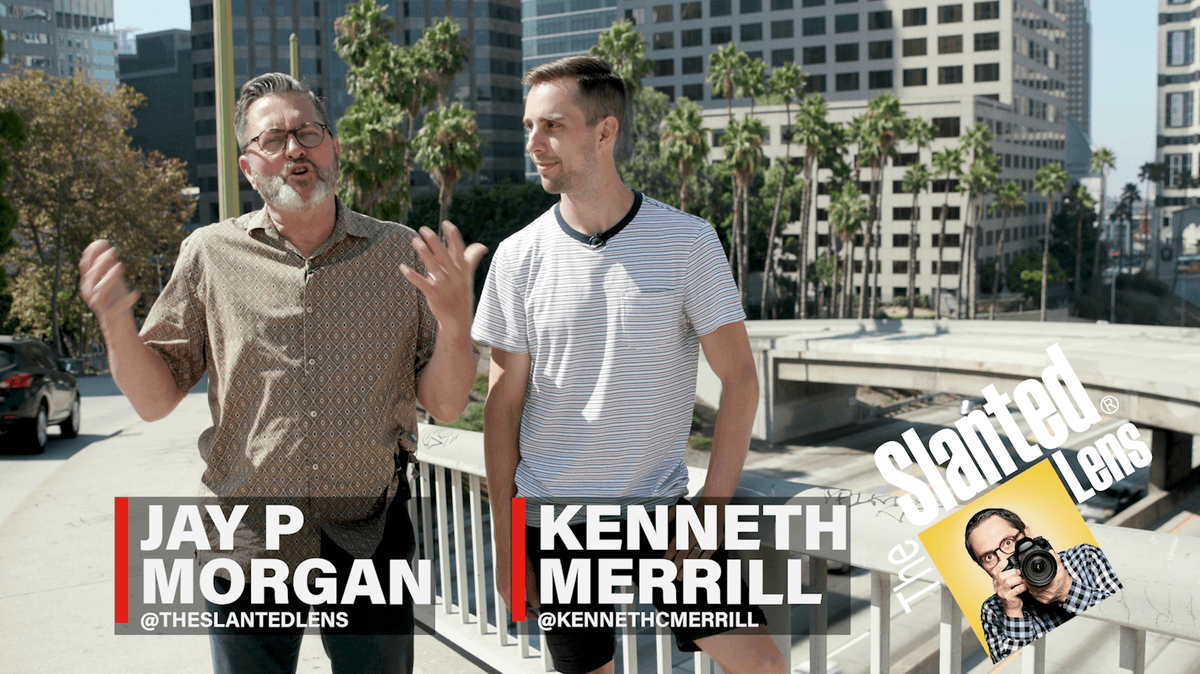 We chose a GFX 100 for the medium format. So we’re going to start with that. We’re going show an Olympus Micro Four Thirds and we’re throwing the Canon EOS R in there because we just want to see something that’s not 60 megapixels like the Sony a7r IV. And then we’re also using a Fuji X-T4.
We chose a GFX 100 for the medium format. So we’re going to start with that. We’re going show an Olympus Micro Four Thirds and we’re throwing the Canon EOS R in there because we just want to see something that’s not 60 megapixels like the Sony a7r IV. And then we’re also using a Fuji X-T4.
We got a bunch of comments on our last format comparison. “You did this wrong, you did this wrong, you did this wrong.” Some of it, honestly, didn’t make a lot of sense but some of the points that people made were really good and we decided to give it another go and try and address some of the issues or perceived issues with our last comparison.
 We are going to look at equivalency this time and if you don’t know what equivalency is take a look at the video we posted last week and that will help you understand equivalency.
We are going to look at equivalency this time and if you don’t know what equivalency is take a look at the video we posted last week and that will help you understand equivalency.
 We got all kinds of blasts from the equivalency police saying that we had handled the sensors wrong. So we’ll compare equivalency today. This is a lot of cameras to look at and to work on. We’ll look at images when we get back to the studio.
We got all kinds of blasts from the equivalency police saying that we had handled the sensors wrong. So we’ll compare equivalency today. This is a lot of cameras to look at and to work on. We’ll look at images when we get back to the studio.
So we’re back in the studio. Now we’re going to take a look at our images. We shot some in daylight and we shot some at dusk into dark. We want to make sure that we are not favoring any format because some people felt like in a more bright situation, some formats will do better and darker situation probably favor the larger formats.
 I will hand it to the equivalency advocates that all of these images look pretty similar, even if we blow them up to full frame. Here’s the Fuji X-T4 at full frame. It looks excellent. It looks beautiful. What people were saying last time is basically if you use equivalency to calculate your exposures for each camera so that you’re capturing the same amount of light, then the images will look identical. So let’s see if that’s the case.
I will hand it to the equivalency advocates that all of these images look pretty similar, even if we blow them up to full frame. Here’s the Fuji X-T4 at full frame. It looks excellent. It looks beautiful. What people were saying last time is basically if you use equivalency to calculate your exposures for each camera so that you’re capturing the same amount of light, then the images will look identical. So let’s see if that’s the case.
 Looking at the images it’s not the case. When looking at a much larger megapixel sensor there is greater detail. But the question is, does the grain look the same? And it looks pretty similar. It’s hard to tell. We pushed in to look at the grain. We’re shooting at 200 ISO and the Olympus is pretty clean. You can only push in so far before you lose resolution. I will say the sky still looks a little cleaner on the GFX, but they are pretty close. So there’s equivalency in exposure. As you’re looking at the GFX, you’re looking at a 1600 ISO to achieve the same image.
Looking at the images it’s not the case. When looking at a much larger megapixel sensor there is greater detail. But the question is, does the grain look the same? And it looks pretty similar. It’s hard to tell. We pushed in to look at the grain. We’re shooting at 200 ISO and the Olympus is pretty clean. You can only push in so far before you lose resolution. I will say the sky still looks a little cleaner on the GFX, but they are pretty close. So there’s equivalency in exposure. As you’re looking at the GFX, you’re looking at a 1600 ISO to achieve the same image.
 Some of the commenters said we’ve had to cripple the Fuji GFX by closing down the aperture and boosting the ISO three stops. And the grain looks very similar. They both look good, but you can get so much more out of that large format if you want to go to 1600. In a second image we shot all the cameras at f/4 as well and we’ll take a look at that. What is interesting is the Sony performs very well, neck and neck with the Fuji. And that 61 megapixel sensor versus the 100 megapixel sensor did well.
Some of the commenters said we’ve had to cripple the Fuji GFX by closing down the aperture and boosting the ISO three stops. And the grain looks very similar. They both look good, but you can get so much more out of that large format if you want to go to 1600. In a second image we shot all the cameras at f/4 as well and we’ll take a look at that. What is interesting is the Sony performs very well, neck and neck with the Fuji. And that 61 megapixel sensor versus the 100 megapixel sensor did well.  Even the Canon looks pretty good. It’s a little more noisy and has a little less resolution of course. You can see the resolution difference there, but it’s not terrible at all.
Even the Canon looks pretty good. It’s a little more noisy and has a little less resolution of course. You can see the resolution difference there, but it’s not terrible at all.

 Next are the images where everything is set to f/4 with all of the same settings. This is not equivalency. Obviously overall the image looks the same. Now we blow up on this GFX and it is just clean and has so much detail. I want to see what the Sony looks like here.
Next are the images where everything is set to f/4 with all of the same settings. This is not equivalency. Obviously overall the image looks the same. Now we blow up on this GFX and it is just clean and has so much detail. I want to see what the Sony looks like here. 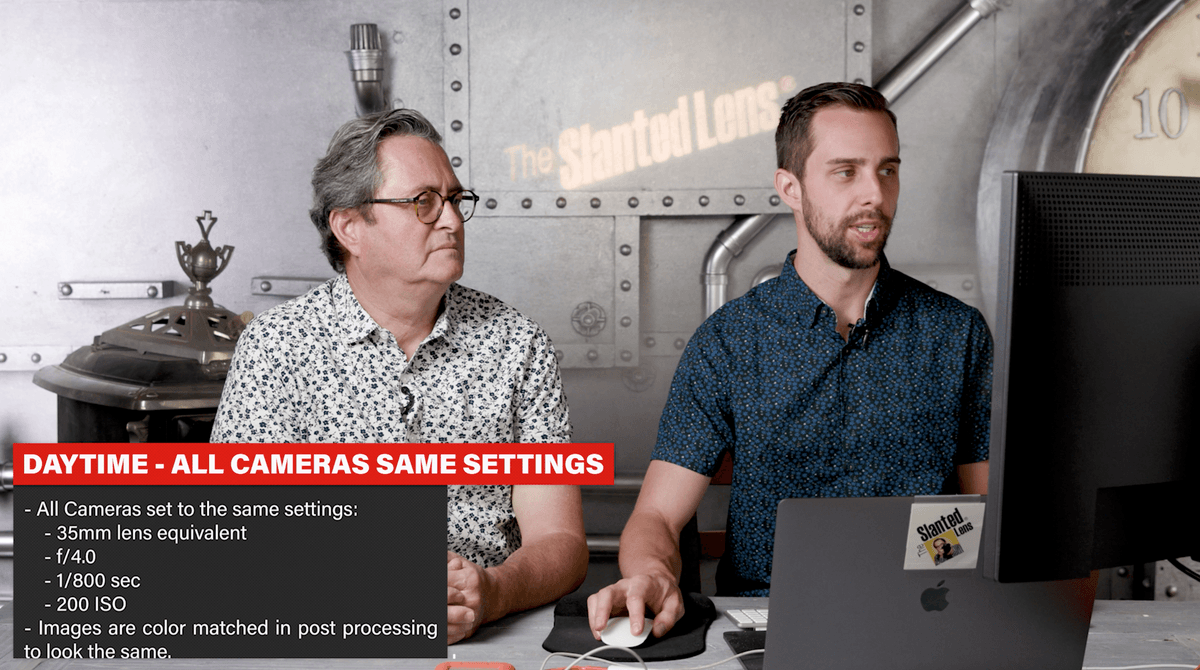 Even though we’ve hampered some of these larger formats because we shot everything in ISO 200, although the full frame cameras both look really good, I’m kind of surprised at how similar they look.
Even though we’ve hampered some of these larger formats because we shot everything in ISO 200, although the full frame cameras both look really good, I’m kind of surprised at how similar they look.  The canon holds up well. There’s really only 30 megapixels but it holds up well. The X-T4 is not looking great. The lens seems weird. Something’s going on here because it’s not sharp. There’s not a lot of detail.
The canon holds up well. There’s really only 30 megapixels but it holds up well. The X-T4 is not looking great. The lens seems weird. Something’s going on here because it’s not sharp. There’s not a lot of detail.
The Olympus is only 20 megapixels and resolution wise it’s just not going to hold up and the Olympus is the only one that’s limited to 200 all these others could go down to 100 ISO and be even cleaner than this.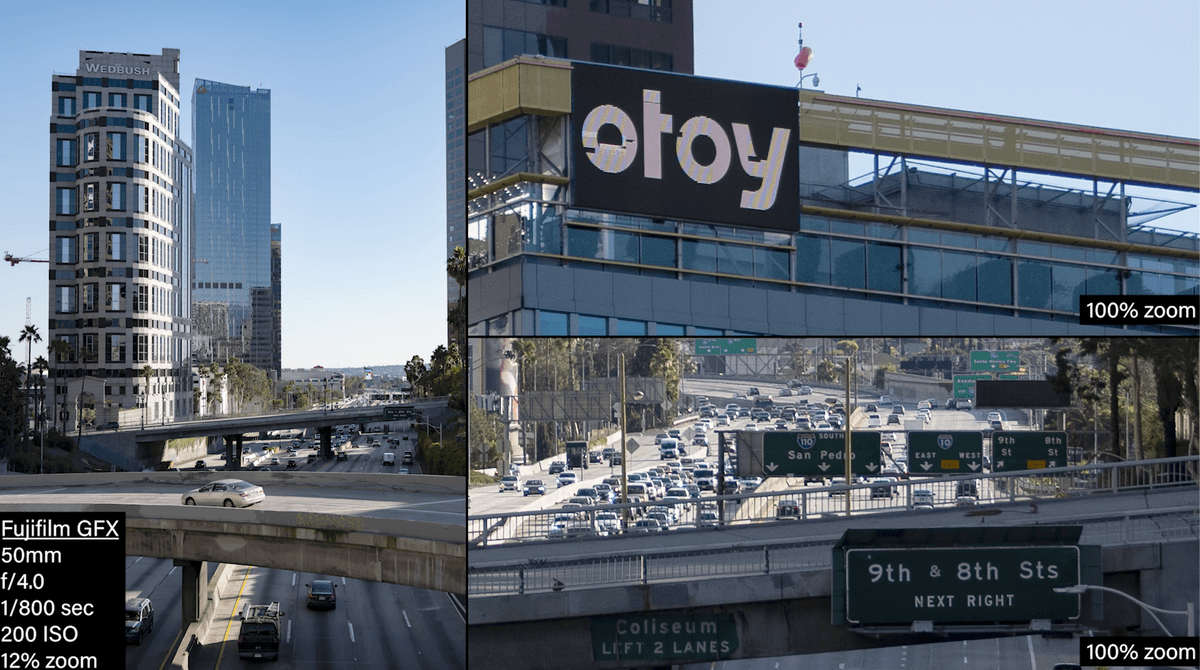



 So this is the nighttime scene that we shot out on the bridge. And when I look at these at this distance, I can honestly say I love the color in that Olympus. It really has beautiful color. In some ways it has the best color rendition up there. There is a clarity with the Fuji GFX, obviously due to resolution.
So this is the nighttime scene that we shot out on the bridge. And when I look at these at this distance, I can honestly say I love the color in that Olympus. It really has beautiful color. In some ways it has the best color rendition up there. There is a clarity with the Fuji GFX, obviously due to resolution.
So we’re at ISO 800 on these full frame images. And this is what I really want to see. Is a 30 megapixel camera going to be cleaner in low light than a 60 megapixel camera? 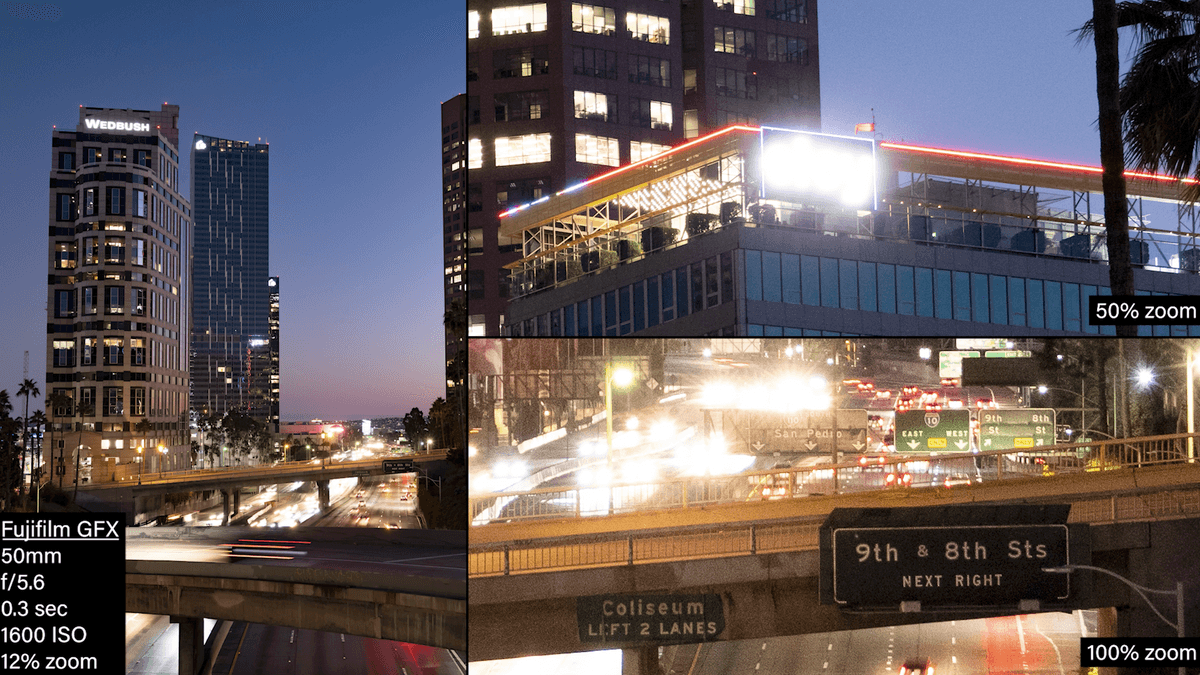 The answer for me is no, I don’t see it. It doesn’t seem cleaner. It seems about the same, in fact the Sony almost seems more clear in some ways. And do you know why? The Sony under exposes. It’s capturing more highlight detail because you’re underexposing.
The answer for me is no, I don’t see it. It doesn’t seem cleaner. It seems about the same, in fact the Sony almost seems more clear in some ways. And do you know why? The Sony under exposes. It’s capturing more highlight detail because you’re underexposing.  Well, what about the Canon? It looks great as well. And what’s going on with the Fuji? It looks like it has a diffusion on and it’s a little soft. But we don’t see it in the building, the buildings are still sharp. Look at these windows on the building.
Well, what about the Canon? It looks great as well. And what’s going on with the Fuji? It looks like it has a diffusion on and it’s a little soft. But we don’t see it in the building, the buildings are still sharp. Look at these windows on the building.  It is still sharp, but for some reason, there’s just more blooming around the highlight on that Fuji X-T4. The Olympus Micro Four Thirds just doesn’t have a lot of detail. It’s a lower resolution camera. Then again, the grain across all these cameras looks somewhat similar.
It is still sharp, but for some reason, there’s just more blooming around the highlight on that Fuji X-T4. The Olympus Micro Four Thirds just doesn’t have a lot of detail. It’s a lower resolution camera. Then again, the grain across all these cameras looks somewhat similar.  I think the Fuji GFX is still the cleanest. I think the Fuji X-T4 is actually performing very well in this scenario. So if you want to talk physics, you can shoot all these cameras so they’re gathering the same amount of light. But because the medium format camera has a larger sensor and is using a longer focal length, when you open up to f/4 or f/2.8, the physical aperture is so much broader, you’re gathering so much more information from the scene. The bigger camera captures so much more information so you get this image at 200 ISO at an f/4 and it’s just beautiful. It’s clean, clean, clean. There’s so much information, there’s so much detail.
I think the Fuji GFX is still the cleanest. I think the Fuji X-T4 is actually performing very well in this scenario. So if you want to talk physics, you can shoot all these cameras so they’re gathering the same amount of light. But because the medium format camera has a larger sensor and is using a longer focal length, when you open up to f/4 or f/2.8, the physical aperture is so much broader, you’re gathering so much more information from the scene. The bigger camera captures so much more information so you get this image at 200 ISO at an f/4 and it’s just beautiful. It’s clean, clean, clean. There’s so much information, there’s so much detail.  And you look at the Olympus and it’s also at 200 ISO at f/4 and it just doesn’t look as good. Look at the grain in the sky in that Olympus. There’s just major grain at 200 ISO in that sky. With the Canon I’m just surprised how well it’s holding up as a 30 megapixel camera compared to the 60 that you have with the Sony.
And you look at the Olympus and it’s also at 200 ISO at f/4 and it just doesn’t look as good. Look at the grain in the sky in that Olympus. There’s just major grain at 200 ISO in that sky. With the Canon I’m just surprised how well it’s holding up as a 30 megapixel camera compared to the 60 that you have with the Sony.
 My takeaway from this is to my eye there actually isn’t a huge quality jump from the Canon to the Sony. They are both full frame. The Sony is even double the megapixels, yet is isn’t going to give you a crazy amount of more detail. The Canon and the Sony are both looking fabulous.
My takeaway from this is to my eye there actually isn’t a huge quality jump from the Canon to the Sony. They are both full frame. The Sony is even double the megapixels, yet is isn’t going to give you a crazy amount of more detail. The Canon and the Sony are both looking fabulous.
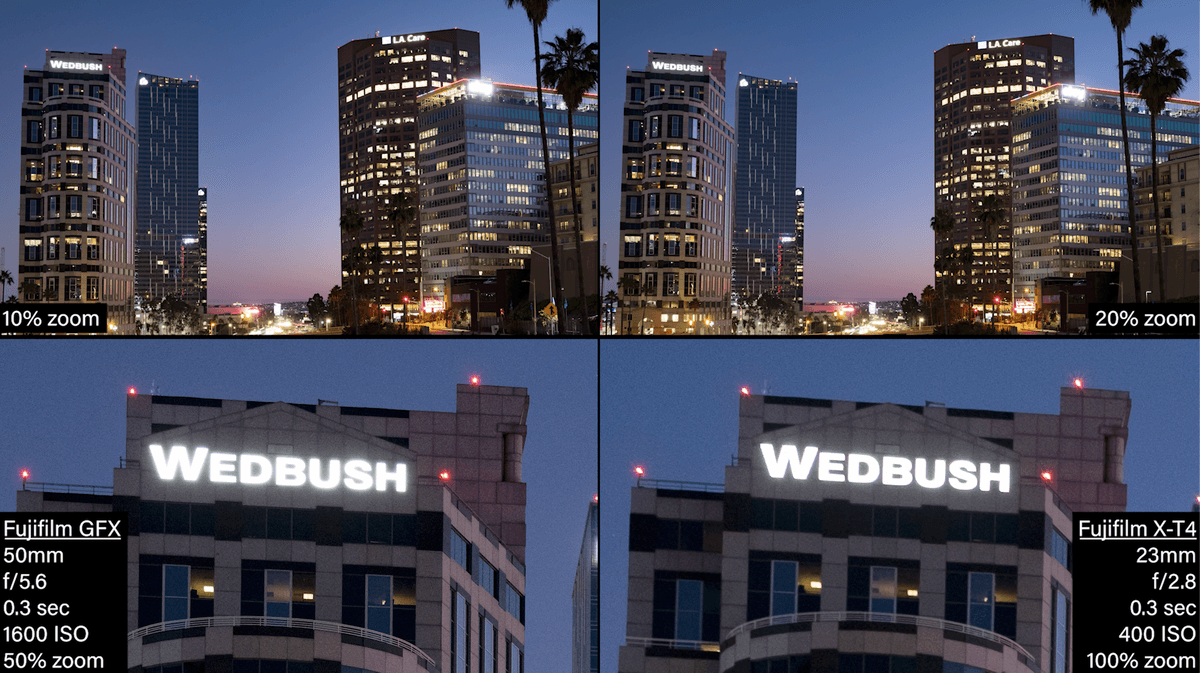 Here the micro four thirds and the crop sensor are struggling. I think the Fuji X-T4 color wise is really nice. The red neon and all the streetlights look great. It has some good transition in tonality from the bottom of the building to the top. It’s actually pretty nice, but the lack of detail on the X-T4 is surprising. I actually expected the image to be better than it is.
Here the micro four thirds and the crop sensor are struggling. I think the Fuji X-T4 color wise is really nice. The red neon and all the streetlights look great. It has some good transition in tonality from the bottom of the building to the top. It’s actually pretty nice, but the lack of detail on the X-T4 is surprising. I actually expected the image to be better than it is.
 For the dynamic range test we set it up this way. We have Jay P sitting here by some windows and we’ve taken three exposures. We’ve exposed for Jay P’s face. Then we shot a middle exposure that is kind of in between the inside and the outside values and then we shot a third exposure that is exposed for the outside and inside is super dark. Then what I’ve done is I brought these into raw and tried to bring back all the detail from the highlights and the shadows to see how much information we can retain in the image.
For the dynamic range test we set it up this way. We have Jay P sitting here by some windows and we’ve taken three exposures. We’ve exposed for Jay P’s face. Then we shot a middle exposure that is kind of in between the inside and the outside values and then we shot a third exposure that is exposed for the outside and inside is super dark. Then what I’ve done is I brought these into raw and tried to bring back all the detail from the highlights and the shadows to see how much information we can retain in the image.  The Olympus seems like the clarity is really clear. It’s a very nice image for that kind of a tough lighting situation. And you know, I will say the Canon really struggled in this scene. It struggled to just retain the color whichever way you were pushing it around. The Olympus does look good. They all look good to my eye.
The Olympus seems like the clarity is really clear. It’s a very nice image for that kind of a tough lighting situation. And you know, I will say the Canon really struggled in this scene. It struggled to just retain the color whichever way you were pushing it around. The Olympus does look good. They all look good to my eye.
 So here is the middle exposure where we are in between. The inside is going to be the underexposed and outside the window is a little overexposed. I was able to bring back the information from outside the window for all the cameras. They did pretty well on this one. The GFX 100 has a nice dynamic range here. We keep the car and we’re not blowing anything out. You are starting to see some texture in the Olympus. With the X-T4 it loses it in the background, especially if we look over here at the plug on the wall. The full frame cameras aren’t really suffering as much.
So here is the middle exposure where we are in between. The inside is going to be the underexposed and outside the window is a little overexposed. I was able to bring back the information from outside the window for all the cameras. They did pretty well on this one. The GFX 100 has a nice dynamic range here. We keep the car and we’re not blowing anything out. You are starting to see some texture in the Olympus. With the X-T4 it loses it in the background, especially if we look over here at the plug on the wall. The full frame cameras aren’t really suffering as much.
 Now we’ve exposed for the outside. Jay P’s face is seven stops underexposed. The Fuji GFX is showing noise around his left eye and left side of his face. The Sony looks pretty good too. I mean, it’s a little noisier. You see the blotchiness in the skin tone. The Canon is definitely noisier and it has the same blotches in the color.
Now we’ve exposed for the outside. Jay P’s face is seven stops underexposed. The Fuji GFX is showing noise around his left eye and left side of his face. The Sony looks pretty good too. I mean, it’s a little noisier. You see the blotchiness in the skin tone. The Canon is definitely noisier and it has the same blotches in the color.
 A lot of people argue that if you have larger megapixels, you have more dynamic range. This actually illustrates that that’s not the case. The Canon has less color information here in the skin. Everything about the image is more gray and the grain structure is larger, the grain is grittier, there’s less detail to the image. So the Sony with the higher megapixel count, the smaller pixels are giving a better image even in the shadows with the dynamic range. The Fuji has cleaner color. You don’t get the blotchiness to it, it is grittier, and it’s doing really well. I like how the Fuji is doing in this scenario. And then of course the Olympus again, not so much blotchiness, but it’s really crunchy. The grain pattern is really strong. We don’t see the blotchiness and all that. That’s nice to know. Although, the reality is that the grain is so heavy that there’s just not as much to look at. It’s really struggling.
A lot of people argue that if you have larger megapixels, you have more dynamic range. This actually illustrates that that’s not the case. The Canon has less color information here in the skin. Everything about the image is more gray and the grain structure is larger, the grain is grittier, there’s less detail to the image. So the Sony with the higher megapixel count, the smaller pixels are giving a better image even in the shadows with the dynamic range. The Fuji has cleaner color. You don’t get the blotchiness to it, it is grittier, and it’s doing really well. I like how the Fuji is doing in this scenario. And then of course the Olympus again, not so much blotchiness, but it’s really crunchy. The grain pattern is really strong. We don’t see the blotchiness and all that. That’s nice to know. Although, the reality is that the grain is so heavy that there’s just not as much to look at. It’s really struggling.
 Okay, so with 3200 ISO it obviously benefits the large format. You can shoot at 3200 ISO and the image still retains a lot of detail. It looks super clean. What I’m most curious about is how does this Sony stack up versus the Canon? They look about the same they look very similar.
Okay, so with 3200 ISO it obviously benefits the large format. You can shoot at 3200 ISO and the image still retains a lot of detail. It looks super clean. What I’m most curious about is how does this Sony stack up versus the Canon? They look about the same they look very similar. 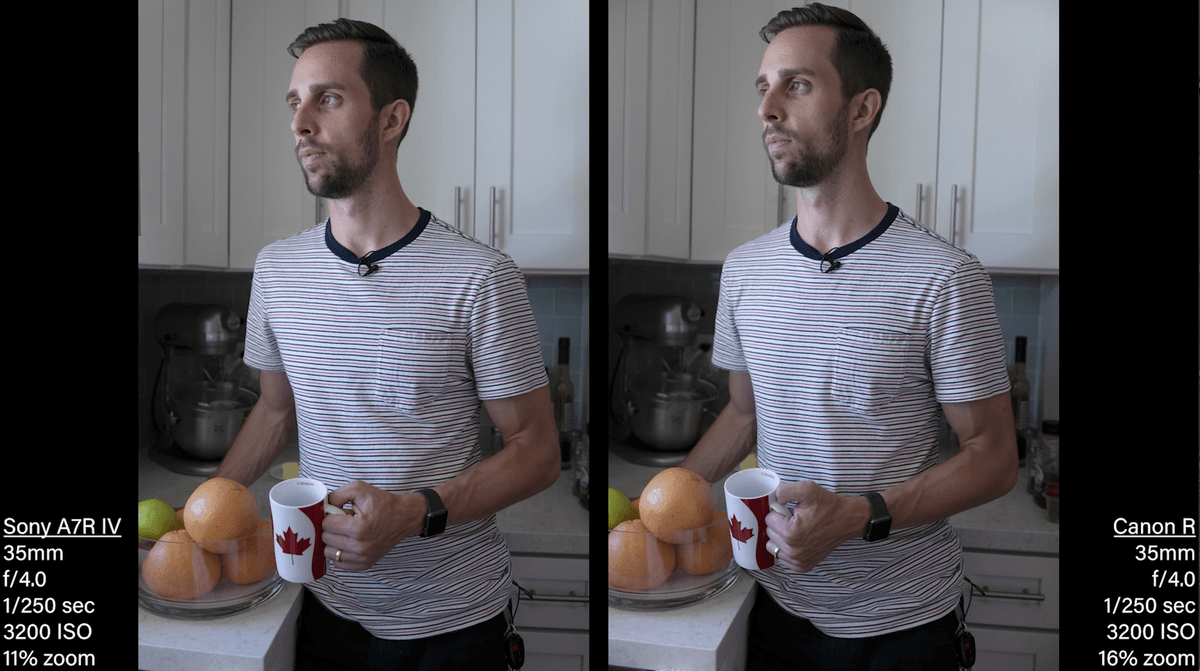 So that megapixel difference doesn’t make a huge difference. There is more detail in the Sony. You can see more eyelashes. The Fuji XT-4 is doing quite well for 3200 ISO. I see it more here in the scan that’s in the background, the face is not as clean.
So that megapixel difference doesn’t make a huge difference. There is more detail in the Sony. You can see more eyelashes. The Fuji XT-4 is doing quite well for 3200 ISO. I see it more here in the scan that’s in the background, the face is not as clean.  See what the Micro Four Thirds looks like. It is worse than the Fuji XT-4. This Fuji X-T4 seems to do well in underexposed situations, low light situations. Just look at the blotchiness in the white cabinets behind. The grain pattern is irregular. But there’s a little more clarity to Jay P’s face in the Olympus which is interesting.
See what the Micro Four Thirds looks like. It is worse than the Fuji XT-4. This Fuji X-T4 seems to do well in underexposed situations, low light situations. Just look at the blotchiness in the white cabinets behind. The grain pattern is irregular. But there’s a little more clarity to Jay P’s face in the Olympus which is interesting.
Well, there’s an interesting comparison. I hope you enjoyed this. Leave your comments on our YouTube channel on how you think we missed the mark and the things you think we did that made sense. Those of you who are really advocates for this equivalency and exposure and looking at these smaller formats, I want to hear how you feel about how we did this test. We really went out of our way to make sure that each of these formats had a fair look at equivalency. And did that really make that much difference? Or is it kind of a physics thing that doesn’t really lend itself to practicality in the way we use these cameras? I do feel like a lot of people will watch a video like this and they’ll feel like, oh man, my camera really got pooped on. It’s not good enough, etc. That’s not the purpose of this this kind of comparison or lesson. We’re not trying to say, oh yeah, if you have a Micro Four Thirds camera it’s worthless. I’ve never really paid too much attention to format size especially when it comes to cinema. So I’m pretty agnostic about format. I think I’m just looking at the examples here and saying these are what these cameras are capable of. If you’re trying to get a particular kind of image and you want a particular kind of tool, that’s what it’s about. So it’s really just about informing people, what their tools should look at for different applications and the limitations and the benefits of these different formats.
So now you have the information. You need to be able to make a decision on where you’re going to spend your money. That is really what it’s all about. And most of us have kind of made that decision and found ourselves in a lens camp and a camera camp. You don’t have to prove its best. You got what you paid for.
Make sure you subscribe to The Slanted Lens. We have more coming so keep those cameras rollin’ and keep on clickin’.
Enter the GIVEAWAY! Win a Westcott 1-Light Backpack Kit: https://theslantedlens.com/giveaway/
Thanks to LensProToGo for providing the lenses and cameras for this sensor size comparison! Get 15% off your rental from LensProToGo. Got to https://www.lensprotogo.com and use the Discount Code: SLANTEDLENS15
Thanks to FotoproUSA for providing Tripods for this comparison: http://www.fotoprousa.com/
Fujifilm GFX 100 Medium Format: B&H – https://bhpho.to/2XvnvWa Amazon – https://amzn.to/3iE9Sfs
Sony a7r IV Full Frame: B&H – https://bhpho.to/2DaTi8b Amazon – https://amzn.to/2PMthyw
Canon EOS R Full Frame: B&H – https://bhpho.to/2DPcFUr Amazon – https://amzn.to/2XYbF7w
Fujifilm X-T4 APS-C Format: B&H – https://bhpho.to/31hQXAd Amazon – https://amzn.to/2E5bekn
Olympus OM-D E-M1 Micro Four Thirds Format: B&H – https://bhpho.to/30sHQNR Amazon – https://amzn.to/3iDZ8xP
Check out the Westcott FJ400 1-Light Backpack Kit: https://www.fjwestcott.com/fj400-strobe-1-light-backpack-kit-with-fj-x2m-universal-wireless-trigger-and-rapid-box-switch-octa-s?acc=d09bf41544a3365a46c9077ebb5e35c3

SHOW US SOME LOVE! SUBSCRIBE! Subscribe to The Slanted Lens and get new videos every Thursday http://bit.ly/1RgdYoM
Leave a Reply